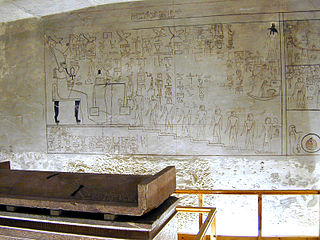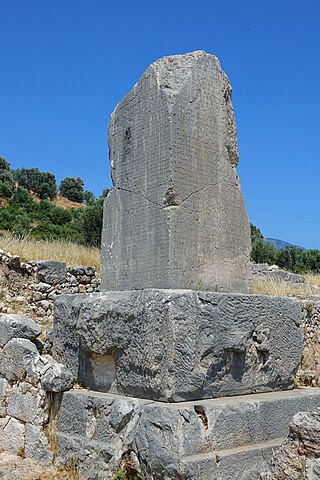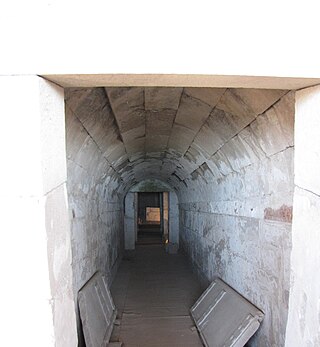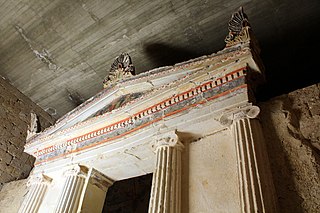
The Ajanta Caves are 29 rock-cut Buddhist cave monuments dating from the second century BCE to about 480 CE in the Aurangabad District of Maharashtra state in India. Ajanta Caves are a UNESCO World Heritage Site. Universally regarded as masterpieces of Buddhist religious art, the caves include paintings and rock-cut sculptures described as among the finest surviving examples of ancient Indian art, particularly expressive paintings that present emotions through gesture, pose and form.

Tomb WV22, also known as KV22, was the burial place of the Eighteenth Dynasty pharaoh Amenhotep III. Located in the Western arm of the Valley of the Kings, the tomb is unique in that it has two subsidiary burial chambers for the pharaoh's wives Tiye and Sitamen. It was officially discovered by Prosper Jollois and Édouard de Villiers du Terrage, engineers with Napoleon's expedition to Egypt in August 1799, but had probably been open for some time. The tomb was first excavated by Theodore M. Davis, the details of which are lost. The first documented clearance was carried out by Howard Carter in 1915. Since 1989, a Japanese team from Waseda University led by Sakuji Yoshimura and Jiro Kondo has excavated and conserved the tomb. The sarcophagus is missing from the tomb. The tomb's layout and decoration follow the tombs of the king's predecessors, Amenhotep II (KV35) and Thutmose IV (KV43); however, the decoration is much finer in quality. Several images of the pharaoh's head have been cut out and can be seen today in the Louvre.

QV66 is the tomb of Nefertari, the Great Wife of Pharaoh Ramesses II, in Egypt's Valley of the Queens. It was discovered by Ernesto Schiaparelli in 1904. It is called the Sistine Chapel of Ancient Egypt. Nefertari, which means "beautiful companion", was Ramesses II's favorite wife; he went out of his way to make this obvious, referring to her as "the one for whom the sun shines" in his writings, built the Temple of Hathor to idolize her as a deity, and commissioned portraiture wall paintings. In the Valley of the Queens, Nefertari's tomb once held the mummified body and representative symbolisms of her, consistent with most Egyptian tombs of the period. Now, everything had been looted except for two thirds of the 5,200 square feet of wall paintings. For what still remains, these wall paintings characterized Nefertari's character. Her face received particular attention to emphasize her beauty, especially the shape of her eyes, the blush of her cheeks, and her eyebrows. Some paintings were full of lines and color of red, blue, yellow, and green that portrayed exquisite directions to navigating through the afterlife to paradise.

Tomb KV43 is the tomb of Pharaoh Thutmose IV in the Valley of the Kings in Luxor, Egypt. It has a dog-leg shape, typical of the layout of early 18th Dynasty tombs. KV43 was rediscovered in 1903 by Howard Carter, excavating on behalf of Theodore M. Davis.

Tomb KV57 is the royal tomb of Horemheb, the last pharaoh of the Eighteenth Dynasty and is located in the Valley of the Kings, Egypt.

Veerabhadra temple is a Hindu temple located in the Lepakshi, in the state of Andhra Pradesh, India. The temple is dedicated to the Virabhadra, a fierce incarnation of Lord Shiva. Built in the 16th century, the architectural features of the temple are in the Vijayanagara style with profusion of carvings and paintings at almost every exposed surface of the temple. It is one of the centrally protected monuments of national importance and is considered one of the most spectacular Vijayanagara temples. The fresco paintings are particularly detailed in very bright dresses and colours with scenes of Rama and Krishna from the epic stories of the Ramayana, the Mahabharata and the Puranas and they are well preserved. There is a very large Nandi (bull), mount of Shiva, about 200 metres (660 ft) away from the temple which is carved from a single block of stone, which is said to be one of the largest of its type in the world. The temple is home to many Kannada inscriptions as its located close to Karnataka border.

The Church of Panagia Chalkeon is an 11th-century Byzantine church in the northern Greek city of Thessaloniki. The church's well-preserved Byzantine architecture and testimony to the importance of Thessaloniki in early and medieval Christianity led it to be inscribed on the UNESCO World Heritage List in 1988 along with other Paleochristian and Byzantine monuments of Thessaloniki.

The Museum of Byzantine Culture is a museum in Thessaloniki, Central Macedonia, Greece, which opened in 1994.

The Illyrian Tombs of Selca e Poshtme are located near the town of Pogradec in Albania near the village of Selcë e Poshtme. On the right bank of the river Shkumbin at an elevation of 1040 m above sea level, lie the remains of the ancient city of Pelion and the accompanying necropolis. The Roman Via Egnatia led past it towards Thessaloniki. Though there are traces of human activity in Neolithic times, the settlement proper dates to the Iron Age through to the Illyrian urban period, and reached its height under settlement by the Illyrian tribe of Enchele in the later Iron Age and was also occupied in the Roman period as traces of a municipal building show. From the 4th to 1st centuries BC the city was the royal residence of Illyrian kings and therefore, also probably an important political and economic centre. In 1996, Albania included the Royal tombs of Selca e Poshtme in the UNESCO World heritage list of proposals.

St Lawrence's Church is a redundant Anglican church in the parish of Snarford, Lincolnshire, England. It is recorded in the National Heritage List for England as a designated Grade I listed building, and is under the care of the Churches Conservation Trust. The church stands to the north of the A46 road between Market Rasen and Lincoln. It is a medieval building containing impressive 16th- and 17th-century monuments.

The Montemirabile or Saint John the Baptist Chapel, otherwise the Baptistery is the first side chapel in the left aisle in the Basilica of Santa Maria del Popolo.

The Church of St. George is a 12th-century Macedonian Orthodox church located 2 km away from the village of Kurbinovo in North Macedonia. Excavations have shown that the building has once belonged to a settlement, which was abandoned at the end of the 18th century for the present-day village of Kurbinovo. According to the research made on the church's frescoes, it is supposed that the church was built in the year 1191 by the Byzantines. The church is a "monument of culture" in the Republic of North Macedonia and protected by law. It is also a part of the Prespa - Pelagonia diocese of the Macedonian Orthodox Church.

The Kasta Tomb, also known as the Amphipolis Tomb, is the largest ancient tumulus ever discovered in Greece, and by comparison dwarfs that of Philip II of Macedon, father of Alexander the Great, in Vergina.

Monuments in the Basilica of Santa Maria del Popolo are tombs and funerary monuments ranging from the 15th to the 19th centuries. Since its rebuilding in the 1470s by Pope Sixtus IV the Basilica of Santa Maria del Popolo was one of the favourite burial places for members of the papal aristocracy, clergy and literati. Foreign artists were also buried in the church due to its location near their favourite quarter in Rione Campo Marzio. The high number of tombs and monuments makes the basilica a whole museum of sculpture as Jacob Burckhardt phrased it in his famous guide of Italian art in 1855. Besides the tombs in the side chapels and the choir there are many other funeral monuments in the aisles and the transept. During the centuries several monuments were demolished and others were relocated to give place to newer ones.

The Tomb of the Dancers or Tomb of the Dancing Women is a Peucetian tomb in Ruvo di Puglia, Italy. It was discovered in the Corso Cotugno necropolis in November 1833. The date of its construction is uncertain, dates ranging from the end of the fifth century BC to the mid-fourth century BC have been proposed. In any case, the tomb's frescoes are the oldest example of figurative painting in Apulia, together with another tomb in Gravina di Puglia. The Peucetians borrowed the practice of painting tombs from the Etruscans, who had an important influence on their culture. The tomb is named after the dancing women which appear on the frescoes in the tomb. The panels with the frescoes are now exhibited in the Naples National Archaeological Museum, inv. 9353.

The theme of death within ancient Greek art has continued from the Early Bronze Age all the way through to the Hellenistic period. The Greeks used architecture, pottery, and funerary objects as different mediums through which to portray death. These depictions include mythical deaths, deaths of historical figures, and commemorations of those who died in war. This page includes various examples of the different types of mediums in which death is presented in Greek art.

In the middle of the 19th century, an important Macedonian tomb, now known as Tomb A, was discovered near the Greek village of Korinos, at the site of ancient Pydna. In 1991 a second, smaller grave was discovered and excavated.

The Tomb of Judgement, also known as the Great Tomb of Lefkadia is an ancient Macedonian tomb of the Hellenistic period in Mieza, noted for its monumental painted facade. It was probably built at the beginning of the third century BC.

The Tomb of the Palmettes, sometimes known as the Rhomiopoulou Tomb, is an ancient Macedonian tomb of the Hellenistic period in Mieza, Macedonia, Greece, noted for the quality of its painted decoration. It was built in the first half of the third century BC.
The Tomb of Macridy Bey (Greek: Τάφος Μακρίδη Μπέη, romanized: tafos makridi bei, also known as the Tomb of Langadas, is an ancient Macedonian tomb of the Classical or early Hellenistic period, on the site of ancient Lete, modern Derveni between Thessaloniki and Langadas, in Central Macedonia, Greece. A number of cist graves and a single chamber tomb are located in the vicinity. The structure seems to date to the late fourth or early third century BCE.




















